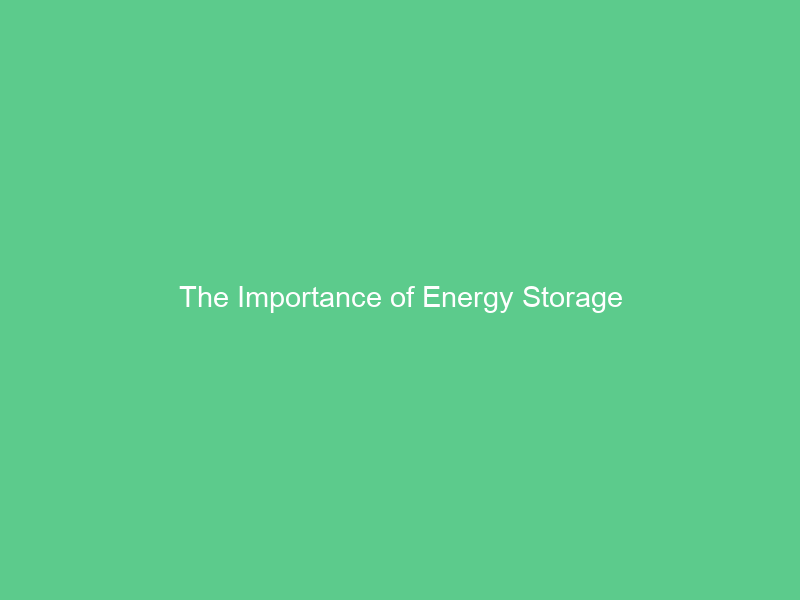
Energy storage is an indispensable technology for increasing renewables in the grid and can prevent price spikes for electricity customers.
Energy Storage technologies span from capacitors that store few Watt-hours for seconds up to grid-scale chemical compounds that store several TeraWatt Hours over many months and years. They can be divided into Mechanical ESS technologies and Electrical ESS technologies.
Resilience
Energy resilience extends beyond backup power systems. It involves safeguarding critical facilities from outages, helping businesses operate with limited or no grid access and supporting communities during emergencies.
Energy storage solutions can support these goals by lowering energy costs, improving reliability and sustainability and helping reduce carbon footprint of facilities or homes. Each organization will have different requirements; to find a suitable solution based on risk exposure, energy loads and other considerations is key to finding success with storage solutions.
An energy storage system (ESS) can enhance the resilience of electricity grids by providing reactive power and helping to stabilize voltage levels, particularly in regions with high renewable penetration where weather conditions can cause significant fluctuations. An ESS is also useful for supporting islanded grid sections without sufficient redundancy or tie lines, microgrids or just facility operations during grid outages quickly as it helps balance supply and demand quickly.
Flexibility
Energy storage is an integral component of a resilient and clean power grid, providing essential ancillary services such as voltage and frequency regulation to balance daily fluctuations in demand and production without disrupting clean sources like wind or solar.
EV battery storage solutions can also serve commercial buildings and large users by providing backup power during outages – providing a return on investment through avoided outage costs. This market segment is expanding quickly, and we anticipate seeing an increasing correlation between network charges and BESS deployment in this area.
Each grid service offers unique economic value, and many storage projects seek to combine multiple services into their project economics in order to optimize them. To accomplish this goal requires careful modeling and site-specific time series analysis of system performance. One solution for approaching this problem would be managing energy (kWh) and power (kW) flexibility reserves independently – this gives more potential flexibility potential than traditional approaches that merge reserve capacities together during operation optimization processes.
Cost
Energy storage systems (ESSs) can play an important role in lowering the costs of clean energy production. With this technology, electricity generated can be stored and used at different times when demand for it spikes (for instance during hot summer afternoons). Furthermore, they enable solar firming, increasing renewable resources’ value to the grid.
Energy Storage technologies vary in terms of both capacity and discharge duration, with lithium-ion batteries currently accounting for most energy storage deployments. Other technologies used include pumped hydro, compressed air storage systems, superconducting magnets and thermal energy storage.
These technologies can reduce the cost of providing electricity to homes and businesses by replacing fossil fuel “peaker” plants, which typically operate during short periods of high electricity demand in cities, contributing to climate change while worsening health issues for low-income communities and people of color. Smartly deployed storage can also defer or even prevent upgrades on power lines over long distances that would be otherwise necessary.
Integration
Energy storage is key to the integration of renewables into electricity grids. It helps balance supply and demand, improve quality and reliability, reduce costs for all electricity consumers and prevent outages by providing services like maintaining frequency on an almost second-by-second basis, operating reserves or voltage regulation. Furthermore, it may help prevent outages by absorbing or discharging electricity as needed from renewable energy sources into the grid when power outages arise.
Energy storage can supplement inefficient, polluting fossil fuel peaker plants during periods of high energy demand (such as during the hottest summer days). This process, known as peak shaving, could lower our electricity bills by eliminating price spikes for electricity customers. Intelligent energy storage technologies like PEAK IQ from Convergent make data-driven decisions about when and how to charge and discharge energy storage systems for maximum value creation and stacking – creating a smarter grid capable of accommodating more renewables as they come online.

